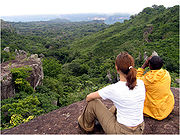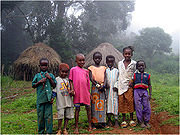
Fouta Djallon
Encyclopedia

Highland (geography)
The term highland or upland is used to denote any mountainous region or elevated mountainous plateau. Generally speaking, the term upland tends to be used for ranges of hills, typically up to 500-600m, and highland for ranges of low mountains.The Scottish Highlands refers to the mountainous...
region in the centre of Guinea
Guinea
Guinea , officially the Republic of Guinea , is a country in West Africa. Formerly known as French Guinea , it is today sometimes called Guinea-Conakry to distinguish it from its neighbour Guinea-Bissau. Guinea is divided into eight administrative regions and subdivided into thirty-three prefectures...
, West Africa
West Africa
West Africa or Western Africa is the westernmost region of the African continent. Geopolitically, the UN definition of Western Africa includes the following 16 countries and an area of approximately 5 million square km:-Flags of West Africa:...
. The indigenous name is Fuuta-Jaloo (sometimes spelled Fuuta Jalon; Fouta Djallon is a French spelling; in English it is sometimes also written Futa Jalon). The origin of the name is from the Fula
Fula language
The Fula or Fulani language is a language of West Africa. It is spoken as a first language by the and related groups from Senegambia and Guinea to Cameroon and Sudan...
word for the region and the name of the original inhabitants, the Jalonke or Djallonké.
Geography
Fouta Djallonke consists mainly of rolling grasslandGrassland
Grasslands are areas where the vegetation is dominated by grasses and other herbaceous plants . However, sedge and rush families can also be found. Grasslands occur naturally on all continents except Antarctica...
s, at an average elevation of about 900m (3,000 ft). The highest point, Mount Loura
Mount Loura
Mount Loura, alt. 1515 m is the northernmost point and highest peak in the Fouta Djallon in northern Guinea. It is 7 km from the prefecture of Maali . It is part of a complex of mountains called the Massif de Tamgue, which rises to steep cliffs on three sides, and provides views into Senegal...
, rises to 1,515m (4,970 ft). The plateau consists of thick sandstone
Sandstone
Sandstone is a sedimentary rock composed mainly of sand-sized minerals or rock grains.Most sandstone is composed of quartz and/or feldspar because these are the most common minerals in the Earth's crust. Like sand, sandstone may be any colour, but the most common colours are tan, brown, yellow,...
formations which overlie granitic basement rock. Erosion
Erosion
Erosion is when materials are removed from the surface and changed into something else. It only works by hydraulic actions and transport of solids in the natural environment, and leads to the deposition of these materials elsewhere...
by rain
Rain
Rain is liquid precipitation, as opposed to non-liquid kinds of precipitation such as snow, hail and sleet. Rain requires the presence of a thick layer of the atmosphere to have temperatures above the melting point of water near and above the Earth's surface...
and river
River
A river is a natural watercourse, usually freshwater, flowing towards an ocean, a lake, a sea, or another river. In a few cases, a river simply flows into the ground or dries up completely before reaching another body of water. Small rivers may also be called by several other names, including...
s has carved deep jungle
Jungle
A Jungle is an area of land in the tropics overgrown with dense vegetation.The word jungle originates from the Sanskrit word jangala which referred to uncultivated land. Although the Sanskrit word refers to "dry land", it has been suggested that an Anglo-Indian interpretation led to its...
canyon
Canyon
A canyon or gorge is a deep ravine between cliffs often carved from the landscape by a river. Rivers have a natural tendency to reach a baseline elevation, which is the same elevation as the body of water it will eventually drain into. This forms a canyon. Most canyons were formed by a process of...
s and valley
Valley
In geology, a valley or dale is a depression with predominant extent in one direction. A very deep river valley may be called a canyon or gorge.The terms U-shaped and V-shaped are descriptive terms of geography to characterize the form of valleys...
s into the sandstone.The word Djallonke originated from the people who originally occupied highlands of Guinea commonly known as SUSU.Djallonke and SUSU are interchangeable.
It receives a great deal of rainfall, and the headwaters of three major rivers, the Niger River
Niger River
The Niger River is the principal river of western Africa, extending about . Its drainage basin is in area. Its source is in the Guinea Highlands in southeastern Guinea...
, the Gambia River
Gambia River
The Gambia River is a major river in West Africa, running from the Fouta Djallon plateau in north Guinea westward through Senegal and The Gambia to the Atlantic Ocean at the city of Banjul...
and the Senegal River
Sénégal River
The Sénégal River is a long river in West Africa that forms the border between Senegal and Mauritania.The Sénégal's headwaters are the Semefé and Bafing rivers which both originate in Guinea; they form a small part of the Guinean-Malian border before coming together at Bafoulabé in Mali...
, have their sources on it. It is thus sometimes called the watertower (chateau d'eau in French literature) of West Africa. Some authors also refer to Fouta Jallonke as the Switzerland of West Africa.
Population
The population consists predominantly of Fula or FulaniFula people
Fula people or Fulani or Fulbe are an ethnic group spread over many countries, predominantly in West Africa, but found also in Central Africa and Sudanese North Africa...
people (who call themselves Fule [sing. Pullo] and are known in French as Peul). In Fuuta-Jaloo their language is called Pular
Pular language
Pular is a Fula language spoken primarily by Fula people in the Fouta Jalon area in Guinea. It is also spoken in parts of Guinea Bissau, Sierra Leone, and Senegal. There are a small number of speakers in Mali. Pular is spoken by 2.5 million Guineans, about 28% of the national population. This makes...
, which is a dialect of Fula
Fula language
The Fula or Fulani language is a language of West Africa. It is spoken as a first language by the and related groups from Senegambia and Guinea to Cameroon and Sudan...
like Pulaar in Senegambia and Fulfulde further east in West Africa
West Africa
West Africa or Western Africa is the westernmost region of the African continent. Geopolitically, the UN definition of Western Africa includes the following 16 countries and an area of approximately 5 million square km:-Flags of West Africa:...
, but with some particular characteristics.
History
Since the 17th century it has been a stronghold of IslamIslam
Islam . The most common are and . : Arabic pronunciation varies regionally. The first vowel ranges from ~~. The second vowel ranges from ~~~...
, when in 1690 jihad against Muslim aristocrats who were selling their own subjects to European slave traders began. The revolutionaries set up a federation divided into nine provinces of Futa Jallonke. When the last revolutionary leaders died in 1751, new leaders took their place and joined slave trading. Several succession crises weakened the central power located in Timbo
Timbo
Timbo is a town and sub-prefecture in the Mamou Prefecture in the Mamou Region of Guinea.It is located in the Fouta Djallon highlands of Guinea, lying north east of Mamou, in a part of the country mostly occupied by the Fula people. It was formerly an important religious centre and is still...
until 1896, when the last Almamy, Bubakar Biro, was defeated by the French army in the battle of Poredaka.
The Fulɓe of Fouta Djallonke spearheaded the expansion of Islam in Guinea. Fulɓe Muslim scholars developed an indigenous literature using the Arabic alphabet. Known as Ajamiyya
Ajami script
The term Ajami , or Ajamiyya , which comes from the Arabic root for "foreign" or "stranger," has been applied to Arabic alphabets used for writing African languages....
, this literary achievement is represented by such great poet-theologians as Tierno Muhammadu Samba Mombeya, Tierno Saadu Dalen, Tierno Aliou Boubha Ndyan, Tierno Jaawo Pellel etc. In its heyday, Fuuta-Jaloo was "a magnet of learning, attracting students from Kankan to the Gambia, and featuring Jakhanke clerics at Tuba as well as Fulbhe teachers. It acted as the nerve centre for trading caravans heading in every direction. The more enterprising commercial lineages, of whatever ethnic origin, established colonies in the Futanke hills and along the principal routes. It served their interests to send their sons to Futanke schools, to support the graduates who came out to teach, and in general to extend the vast pattern of influence that radiated from Futa Jalon"
Amadou Hampâté Bâ
Amadou Hampâté Bâ
Amadou Hampâté Bâ was a Malian writer and ethnologist.-Biography:...
has called Fuuta-Jaloo "the Tibet of West Africa" in homage to the spiritual and mystic (Sufi) tradition of its clerics.

Rural
The Fulɓe in Fouta Djallonke are sedentary. Animal husbandry is important, and cattle, sheep and goats graze in open areas.The main field crop is fonio
Fonio
Fonio is the term for cultivated grains in the Digitaria genus. These are notable in parts of West Africa and one species in India. The grains are very small.-White fonio :...
, although rice
Rice
Rice is the seed of the monocot plants Oryza sativa or Oryza glaberrima . As a cereal grain, it is the most important staple food for a large part of the world's human population, especially in East Asia, Southeast Asia, South Asia, the Middle East, and the West Indies...
is grown in richer soils. Most soils degrade quickly and are highly acidic with aluminum toxicity, which limits the kind of crops that can be grown without significant soil management. A traditional system of gardening, notably women's or kitchen gardens called cuntuuje (sing. suntuure) in Pular
Pular
Pular may refer to:*Pular, Afghanistan*Pular language, a Fula language, spoken mainly in Guinea, West Africa*Pular , in Chile...
or tapades in French, involves addition of various organic inputs (kitchen scraps, harvest residues, mulching, manure). These produce a significant quantity and variety of agricultural products. The gardens are always fenced-in to protect against free-grazing animals.
The region's main cash crops are banana
Banana
Banana is the common name for herbaceous plants of the genus Musa and for the fruit they produce. Bananas come in a variety of sizes and colors when ripe, including yellow, purple, and red....
s and other fruit
Fruit
In broad terms, a fruit is a structure of a plant that contains its seeds.The term has different meanings dependent on context. In non-technical usage, such as food preparation, fruit normally means the fleshy seed-associated structures of certain plants that are sweet and edible in the raw state,...
s.
Outmigration
Fouta Djallon has historically had a high degree of emigration, usually short-term, and mainly to SenegalSenegal
Senegal , officially the Republic of Senegal , is a country in western Africa. It owes its name to the Sénégal River that borders it to the east and north...
and Sierra Leone
Sierra Leone
Sierra Leone , officially the Republic of Sierra Leone, is a country in West Africa. It is bordered by Guinea to the north and east, Liberia to the southeast, and the Atlantic Ocean to the west and southwest. Sierra Leone covers a total area of and has an estimated population between 5.4 and 6.4...
.
Further reading
- De Sanderval, La conquête du Fouta-Djallon (Paris, 1899)
- Dölter, Ueber die Capverden nach dem Rio Grande und Futa Dschallon (Leipzig, 1884)
- Noirot, A travers le Fouta-Djallon et le Bamboue (Paris, 1885)
- Marchat, Les rivières du sud et le Fouta-Djallon (Paris, 1906)

